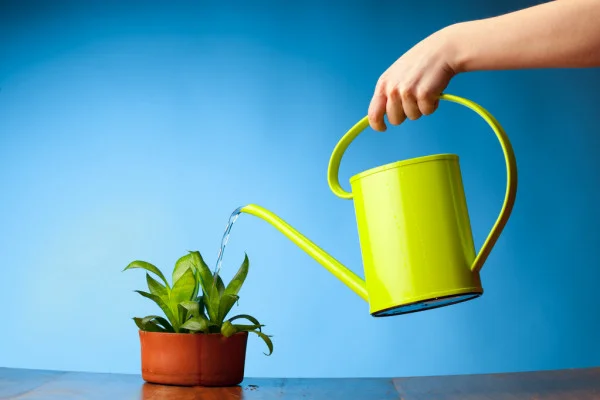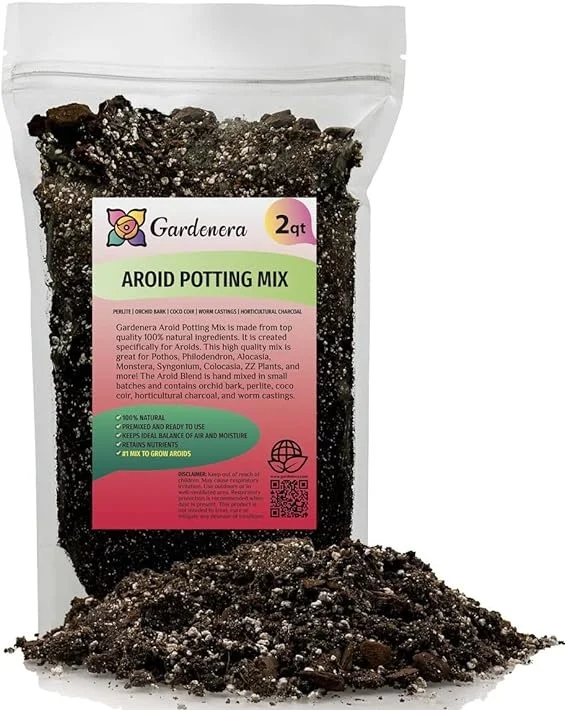How to Water Houseplants Correctly | Watering Indoor Plants the Right Way
Some links in this post may be affiliate links

Most houseplants are killed by overwatering than by any other single cause. Here is a simple guide on the "when" and "how" to water your houseplants.
Water is one of the major requirements for the proper growth of houseplants and without water a houseplant will die.
This may take a day incase of a seedling growing in sandy soil or it may take months incase of a fleshy leaved plant.
This means that providing water for a houseplant is key and not just water but the correct amount, at the right time and the proper way.
Most plants are killed by overwatering than any other single cause. Watering houseplants the proper way is crucial in order to ensure their growth.
For fear of killing their plants, most houseplant owners tend to overwater their plants and in the process killing them.
How often to water houseplants
The frequency of watering is not a constant feature; it depends on the houseplant to be watered, the environment and the time of the year (season).
1. The houseplant to be watered
Lets look at what we need to consider in regard to the houseplant to be watered.
A houseplant with a larger leaf surface area like Schefflera actinophylla and Monstera deliciosa requires more frequent watering than a houseplant with a smaller leaf surface area like Dracaena marginata.
Rapidly growing houseplants require more frequent watering than slow growing houseplants.
Fleshy-leaved houseplants like Snake Plant and other Succulents and Cacti require less frequent watering as they can tolerate much drier conditions than thin-leaved houseplants.
A rooted cutting will require less frequent watering as it takes up far much less water than a mature growing houseplant.
2. The environment of the houseplant
The environment in which the houseplant is growing will affect the frequency of watering in the following ways.
* Temperature
The need for water increases with increase in the temperature of the surrounding.
When air temperature rises, houseplants lose more water to the atmosphere through their leaves inorder to keep themselves cool. Water is also lost from the surface of the soil through evaporation.
These increase the need for more frequent watering of a houseplant in such an environment.
* Light intensity
Houseplants make their food from water and carbon-dioxide in the presence of light through the process of photosynthesis.
This means that with increase in light intensity, more water is absorbed for photosynthesis to take place which results in increased need for more frequent watering.
* Size and type of pot (container)
Houseplants in small pots and those which are pot-bound need more frequent watering than those in larger pots and not root-bound.
Plants in clay pots require more frequent watering than those in plastic pots; clay pots are porous and allow water to evaporate from their surface.
Plants grown in cache pots (double-pots) require less frequent watering than the single potted plants; double potted plants benefit from the reservoir of water at the bottom of the cache pot.
3. The time of the year
During the warm and hot months when the houseplant is actively growing, more frequent watering will be required than during the cold months when the plant is in the resting (dormancy) period.
For plants growing in water like Lucky Bamboo, change the water every 10-14 days to avoid rotting.
When to water houseplants
To avoid killing your houseplants by incorrect watering determine when they need to be watered by feeling the soil with your fingers.
Insert your index finger into the soil up to about 2 in. deep and rub the soil between your fingers.
If the plant's requirement is to keep the soil moist at all times like for Corn Palm and Bamboo Palm, water the plant if the soil feels slightly dry.
Where the plant requires the soil to dry out between waterings, do not water if the soil feels damp but if it feels dry, the plant needs to be watered.
Although an occasional drooping of leaves will do no serious harm to some houseplants like Peace Lily and Spineless Yucca (Yucca gigantea). Do not let them beg for water this way, for when this stage is reached the soil is really too dry.
Roots need air as well as water. This means that the soil should be moist but not saturated or soggy (waterlogged).
Waterlogging (soggy soil) kills the plant by preventing air from getting to the roots and also encourages root-rot diseases.
Some houseplants need partial drying-out period between waterings while others do not.
However, all will need less water during the resting period (cold months). Look up your houseplant's water requirements in this Houseplants A-Z Guide.
Signs of an overwatered houseplants
* Brown leaf tips
* Sudden loss of both old and young leaves
* Leaves are limp with soft and rotten patches
* Poor leaf growth
* Leaves are curled, yellow and wilted
* Flowers are mouldy
* The roots are brown and mushy
Signs of an underwatered houseplant
* Lower leaves are curled, yellow and wilted
* Brown and dry leaf edges
* Leaves are limp and wilted
* Slow growth
* Oldest leaves fall first
* Flowers drop or fade quickly
The water to use for houseplants
The best water for houseplants is chlorine-free water. Most houseplants are sensitive to chlorine, flourides and other chemicals dissolved in water.
The best source of chlorine-free water is rainwater or distilled water.
Ensure that the water is at room-temperature (about 20-240C to avoid shocking your houseplants.
Too hot water will cause root damage and plant shock which may lead to death of plant while too cold water will cause dormancy and stifle any existing and future vegetative growth.
If you only have chlorinated tap water, before using it to water your plants, let it stand in a container overnight to dissipate the chlorine as well as reach room temperature.
Use plain water only. Do not add tea, sugar or coffee to the water.
Sugar attracts insects to your plants which may result in spread of diseases. Coffee and tea increase the acidity of the soil which may kill the plants.
3 Houseplants watering methods
We have outlined herebelow three methods of watering houseplants. The method of watering will depend on the houseplant in question as well as your personal preference.
The best technique for most houseplants is to use the watering can as the standard routine and to water occasionally by the immersion method where possible.
1. Top watering method
In this watering method water is poured over the soil from the top of the pot. You can use a watering can with a long, thin spout to pour the water or you can pour the water directly under a tap or hose.
Pour the water steadily and gently until it drips through the drainage hole.
Keep a tray or plate at the bottom of the pot to catch the excess water.
Do not let the pot sit on the excess water, drain it immediately to avoid waterlogging the soil mixture.
Avoid watering in full sun as splashed leaves may be scorched. The best time to water your houseplants is in the morning so that they can make use of the water during the day in the food making process (photosynthesis).
Avoid wetting the leaf-surface as some houseplants are prone to fungal diseases.
2. Immersion method
Some houseplants do not like water on their leaves or crowns. They are better watered from below.
Immerse the pot in a container of water to just below the level of the soil and leave to soak from below until the surface glistens.
Remove from water and allow the excess water to drain before returning the pot to its usual spot.
3. Bottom watering
Fill the bottom tray or plate with water, replace the plant pot on the tray and make sure that the soil is in contact with the water on the tray.
Allow the soil to absorb the water for about 10 minutes.
Feel the soil with your fingers to test if it has absorbed enough water. If the soil feels moist, discard any excess water from the tray.
If it still feels dry add more water to the tray and allow another 10 minutes for soil to absorb more water, feel the soil again and if it is still dry repeat the process until the soil is moist through out.
Discard the excess water, replace the plant on the tray and return it to its usual growing spot.
Kindly note that bottom watering will not flush out salts and other accumulated chemical from the soil. Therefore, occasionally water the plant from the top to get rid of these salts and chemicals.
Houseplants watering troubles
Common houseplants watering troubles include;
1. Water runs straight through the sides of the pot
When water is poured on the surface of the soil, it immediately runs along the sides of the pot through the drainage hole(s) without wetting the soil.
The reason for this is that the soil has shrunk away from the sides of the pot; the soil has become compacted.
This could be due two reasons; one of the reason is that as the houseplant grows and uses up the nutrients from the soil, the soil disintegrates and reduces in size.
The other reason is that the longer a houseplant remains in one pot without repotting, the more the roots grow and spread in the soil forming a tight ball around the roots.
The problem can be solved by repotting or replacing the soil with fresh soil.
This problem can also be solved by immersing the pot in a container of water to the soil level and allowing some time for the soil to absorb the water, if repotting is not possible.
2. Water is not absorbed by the soil
When water is poured on the surface of the soil, it stands on the surface of the soil without being absorbed by the soil. The reason for this is caking of the soil surface.
This may happen over time due to the quality of soil used or quality of water used for watering and especially if hard water is used to water the houseplants.
This can be solved by breaking up the soil surface by pricking with a fork or a sharp pointed object, immersing the pot in a container of water to the soil level and allowing some time for the soil to absorb water and moisten.
3. The overwatered houseplant
If you have overwatered your houseplant, you can save it by doing the following;
* Drain out the excess water from the pot by tipping the pot on its side for a few minutes.
* To absorb the excess moisture, cover the soil surface with paper towels or tissue paper. Once they become saturated, replace with dry ones until no more water can be absorbed.
* If these measures do not work and the houseplant begins to wilt or lose some leaves, repot the plant with fresh soil into a pot that has drainage hole(s) and avoid overwatering.
You liked it? Share on social media.
Related Content
Amazon Associates Disclosure
Homeplantsguide.com is a participant in the Amazon Services LLC Associates Program, an affiliate advertising program designed to provide a means for sites to earn advertising fees by advertising and linking to amazon.com.





